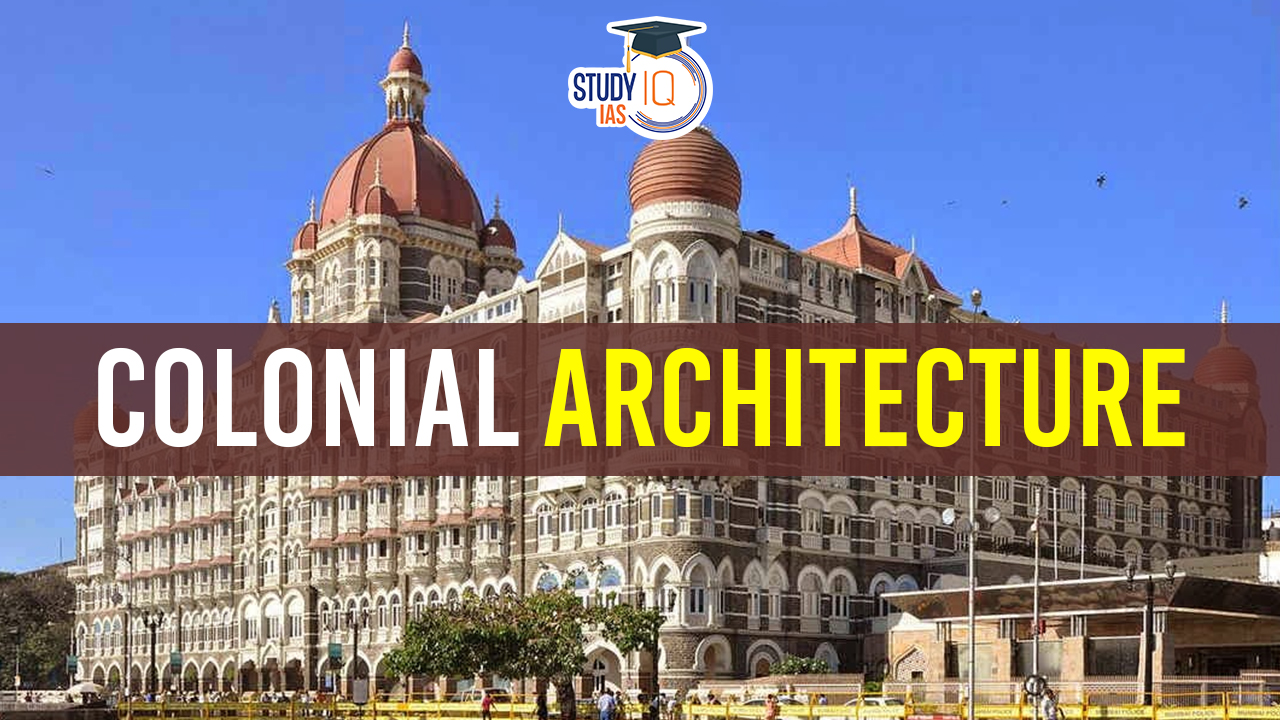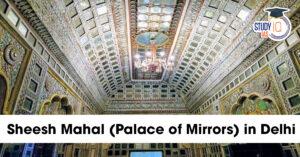Table of Contents
Colonial architecture in India refers to the architectural styles and structures that were built during the period of colonial rule, primarily by the British, Portuguese, Dutch, and French. The colonial period in India spanned several centuries, starting with the arrival of the Portuguese in the 16th century, followed by the Dutch, French, and ultimately the British, who had a significant and lasting impact on Indian architecture.
We’re now on WhatsApp. Click to Join
Colonial Architecture in India
Colonial architecture in India, shaped by British, Portuguese, Dutch, and French influences during their respective periods of rule, embodies a diverse blend of styles. British colonial impact is evident in Indo-Saracenic and Neoclassical structures, such as the Victoria Memorial and Gateway of India. Portuguese influence is seen in Goan Baroque churches and vibrant traditional homes. Dutch colonial legacy includes Fort Dansborg in Tamil Nadu, while French architecture is prominent in Pondicherry’s White Town. Regional adaptations, like colonial bungalows in Shimla and Darjeeling, reflect climatic considerations. These structures, repurposed or preserved, serve as tangible links to India’s colonial history.
Colonial Architecture: Background
In the 18th century, a new era of architecture unfolded in India with the influence of European powers, including the Dutch, Portuguese, English, France, and Denmark. These nations established commercial relations through their respective East India Companies, marking the emergence of European Commercial Companies in India.
Following the Battle of Plassey, the East India Company, particularly the English branch, gained political prominence in India. This dominance extended to architecture, leaving a lasting imprint on the country’s artistic and cultural landscape.
Each European nation brought distinct elements of its culture to India. The Portuguese introduced glitzy art regeneration, the French left their mark on palace and house decorations, and the British imparted their architectural style alongside influencing paintings and sculptures.
Initially marked by attempts to establish authority through classical prototypes, British colonial architecture in India evolved into a distinctive style known as Indo-Saracenic architecture. This unique blend seamlessly incorporates Hindu, Islamic, and Western architectural characteristics.
The manifestation of colonial architecture is evident in institutional, civic, and utilitarian buildings such as official bungalows, post offices, integrated courts, railway stations, and governmental/administrative structures, constructed in large numbers across the nation.
Colonial Architecture: Characteristics
Colonial architecture refers to the architectural styles that emerged during the colonial period, often influenced by the European colonizers and adapted to local conditions. Characteristics of colonial architecture can vary depending on the region and the specific colonial power involved. Here are some general features often associated with colonial architecture:
- Symmetry:
- Colonial architecture is known for its symmetrical design, where the elements on one side of a central axis mirror those on the other. This reflects a sense of balance and order.
- Geometric Shapes:
- Regular use of geometric shapes, such as rectangles, squares, and circles, is common in colonial architecture. These shapes contribute to the overall symmetry of the structures.
- Columns:
- The use of columns is a prominent feature, with styles such as Doric, Ionic, or Corinthian columns being popular. Columns are often used to support a porch or portico.
- Porticos and Porches:
- Many colonial buildings feature porticos or porches, often supported by columns. These architectural elements provide shade and contribute to the aesthetic appeal of the structure.
- Rooflines:
- Gabled roofs are common in colonial architecture. The pitch of the roof may vary, and dormer windows are sometimes incorporated into the roof structure.
- Materials:
- Traditional materials include wood, brick, and stone. The choice of material often depends on the region’s climate and the availability of resources.
- Simplistic Ornamentation:
- While there may be decorative elements, colonial architecture generally features simpler ornamentation compared to later architectural styles. This reflects a practical and functional approach.
- Multi-pane Windows:
- Windows typically have multiple panes, often arranged in a symmetrical pattern. Small, rectangular window panes are a common feature.
- Central Chimneys:
- Colonial homes often have one or more central chimneys. These chimneys served multiple fireplaces in different rooms and helped distribute heat efficiently.
- Practical Layout:
- Colonial homes typically have a practical and efficient layout, with rooms organized around a central hallway. The layout often reflects the lifestyle and needs of the time.
- Pilasters:
- Pilasters, which are shallow, rectangular columns or projections on the exterior of a building, are sometimes used for decorative purposes.
- Influences from European Styles:
- Depending on the colonial power (e.g., English, Dutch, Spanish), there may be influences from European architectural styles like Georgian, Dutch Colonial, or Spanish Colonial.
It’s important to note that colonial architecture can vary significantly across different regions and time periods. The above characteristics provide a general overview, but specific details may differ based on local adaptations and historical influences.
Colonial Architecture: European Influences in India
Portuguese Architecture in India
- Churches in Iberian Style:
- Impressive churches in the Iberian style were established, such as the churches in Goa.
- Francis Church in Cochin (1510) is believed to be the first European church in India.
- Building Materials:
- Portuguese used bricks as the primary building material.
- Wooden roofs and stairs were common.
- Architectural Style:
- Manifestation in churches, cathedrals, and schools in the Iberian style.
- Fortified cities were established from trading terminals and warehouses.
- Baroque Style and Patio Homes:
- Introduction of the ‘Baroque style’ and the concept of ‘patio homes’ symbolizing the Church’s strength.
- Use of clashing colors for a dramatic impact.
- Prominent Structures:
- Sé Cathedral in Goa (1619 AD) in late-Gothic Portuguese style.
- Basilica of Bom Jesus in Goa (1604 AD) in the Baroque style, housing relics of St. Francis Xavier.
- Paul’s Church in Diu (1610 AD) in the Baroque style.
- Diu Fort (1535 AD) with churches like St. Thomas, St. Paul’s, and the Church of St. Francis of Assisi.
- Anne’s Church in Talaulim, Goa (1695 AD) in the Baroque style.
- Bandel Church in West Bengal, Madh Fort, Castella de Aguada, and St. John’s Baptist Church in Mumbai.
French Architecture in India
- Parisian Styles:
- Influence of Parisian architectural styles.
- Use of local raw materials considering climatic conditions.
- Architectural Features:
- French shutter windows, carvings on archways, and narrow street fronts.
- Introduction of French grid patterns, clear sectors, and perpendicular streets in town planning.
- Urban City Planning:
- Introduction of urban city planning with Cartesian grid layouts and scientific architectural designs.
- Construction of massive structures as a display of authority.
- Notable Buildings:
- Statue of Joan of Arc, ‘Le Café,’ Mairie building, French consulate building, and ‘Le Foyer du Soldat.’
British Architecture in India
- Various Architectural Styles:
- Adoption of Gothic, Imperial, Christian, Palladian, and Victorian styles.
- Use of red sandstone and coarse limestone as primary building materials.
- Architectural Examples:
- Gateway of India in Mumbai (Victorian Gothic revival).
- Victoria Terminus Station in Mumbai (Victorian Gothic revival with Indian traditional themes).
- Introduction of Gothic style, Indo-Gothic architectural style, and Neo-Roman architecture.
- Indo-Gothic Style/Victorian Style:
- Unique combination of Indian, Persian, and Gothic elements.
- Pointed arches, large windows, and cruciform ground plans.
- Usage of steel, iron, and poured concrete.
- Neo-Roman Design:
- Emerged after World War I in the buildings of New Delhi.
- Notable for unremarkable structures with a mix of architectural styles.
- Emphasis on circular structures and the use of eastern themes.
Indo-Saracenic Movement
- Bulbous Domes:
- Characteristic feature representing the vault of heaven.
- Examples include Egmore Railway Station and Chennai Museum.
- Overhanging Eaves (Chhajja):
- Protruding structure providing protection for lower walls.
- Incorporated into Indo-Saracenic architecture in structures like Chhatrapathi Shivaji Terminus and Rashtrapati Bhavan.
- Vaulted Roofs and Chhatris:
- Adoption of vaulted roofs and Chhatris from indigenous and Indo-Islamic architecture.
- Examples include St.Matthias’ Church in Chennai and Rashtrapati Bhavan.
- Minarets and Pavilion:
- Inclusion of minarets in structures like the Senate House in Chennai.
- Utilization of pavilions as decorative elements in forts and palaces.
- Cusped Arches:
- Adoption of cusped arches with representations of leaves, flowers, or human heads.
- Examples include Chennai Corporation Building, Rashtrapati Bhavan, and Chhatrapathi Shivaji Terminus.
Post-Independence Era
- Revivalist and Modernist Schools:
- Emergence of two architectural schools after 1947: Revivalist and Modernist.
- Struggle to overcome the colonial hangover, impacting architectural traditions negatively.
- Indo-Gothic and Neo-Roman Styles:
- Continued use of Indo-Gothic and Neo-Roman styles in post-independence architecture.
- Examples include Victoria Memorial in Kolkata and Gateway of India in Mumbai.
- Indo-Saracenic Movement:
- Introduction of the Indo-Saracenic movement representing a blend of imperial and national urges.
- Incorporation of elements from indigenous, Indo-Islamic, Gothic, and Neo-classical styles.
- Architects in Post-Independence Era:
- Laurie Baker, known as the “Architect of the Poor,” emphasizing eco-friendly and cost-effective designs.
- Karl Heinz, a German architect, using local materials and modern styles.
- Le Corbusier, a French architect, designing Chandigarh with a well-ordered matrix and modern features.
- Charles Correa, a Goan architect, focusing on urban design and planning with sensitivity to local needs.
Colonial Architecture UPSC
Colonial architecture in India, shaped by British, Portuguese, Dutch, and French influences, reflects a rich blend of styles. The British left an enduring mark with Indo-Saracenic and Neoclassical structures like the Victoria Memorial. Portuguese influence is evident in Goan Baroque churches, while French architecture graces Pondicherry’s White Town. The Dutch legacy includes Fort Dansborg. These structures, often repurposed, stand as tangible links to India’s colonial history. The post-independence era witnessed a fusion of styles, with architects like Laurie Baker, Karl Heinz, Le Corbusier, and Charles Correa contributing to modern India’s architectural landscape, balancing tradition with innovation.


 Sheesh Mahal in Delhi Restoration, Archi...
Sheesh Mahal in Delhi Restoration, Archi...
 Bonalu Festival 2025: Date, History, Rit...
Bonalu Festival 2025: Date, History, Rit...
 Puri Jagannath Rath Yatra 2025, History,...
Puri Jagannath Rath Yatra 2025, History,...





















